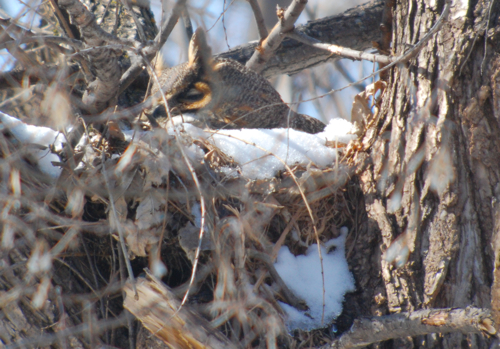 The great horned near my apartment is still incubating--I got this photo on Friday. I think the chicks should have hatched this weekend, hope to see them soon.
The great horned near my apartment is still incubating--I got this photo on Friday. I think the chicks should have hatched this weekend, hope to see them soon.
Uptown Great Horneds Still Around
The Crossley Birds and Beers was a blast. He was a fun interview and a blast after his talk--I think we closed the bar. If you would like to find out if Richard Crossley is coming to your town, check his site.
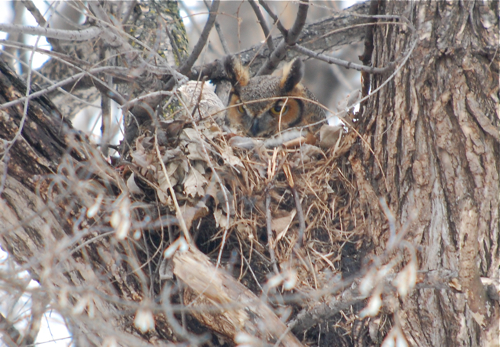
The great horneds near my home continue to incubate. It had been awhile since I took my scope and camera to the owls so I took them out yesterday. Even for a week day, several people passed beneath. The keep an eye on the passers by but otherwise stay still.
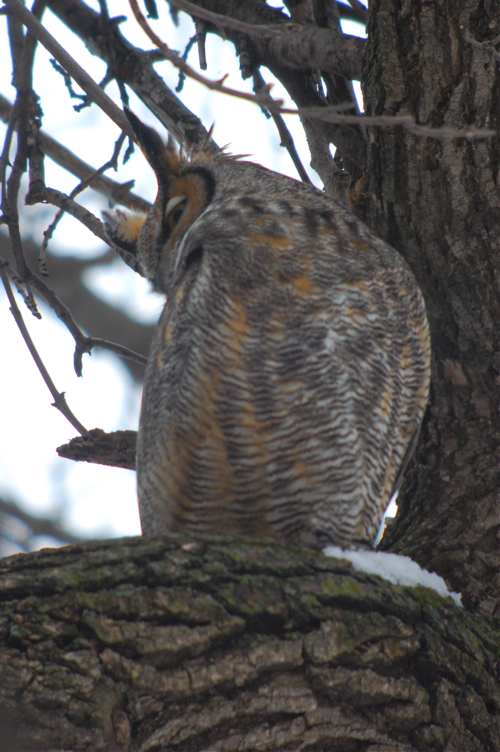
Once again, the male was right over the main walkway. In this photo he's looking down on a dad and his toddler son who had no idea they were walking right under a very large owl. This also leads me to wonder yet again--how many owls do I walk past on a regular basis. I'm willing to bet that the number is very high.
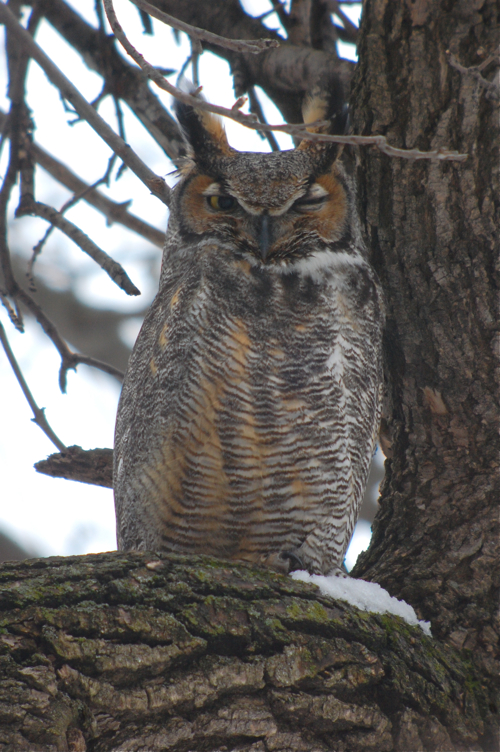
What's An Uptown Owl Eating?
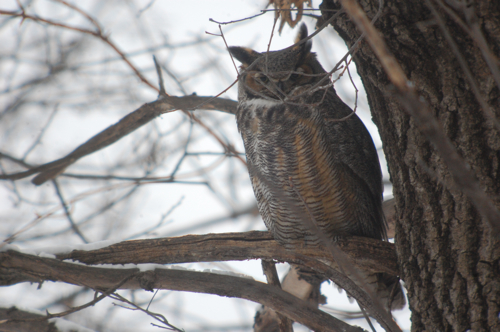 I mentioned earlier that there's a great horned owl pair nesting near my apartment in the Uptown area of Minneapolis. I love that we have such a large bird that is able to hide really well in such an urban area. Also, the distance that this owl is from my home, makes for a nice walk and a good incentive to get out and keep exercising in freezing weather so my biking muscles don't completely atrophy. I digiscoped this photo from the first day I saw the pair nesting, I don't always take my scope and camera. One, walking through urban neighborhoods with that equipment makes home owners uneasy and can lead to police calls. Two, I don't want to aim my scope every day at the owls and the nest to draw further attention and make them uneasy.
I mentioned earlier that there's a great horned owl pair nesting near my apartment in the Uptown area of Minneapolis. I love that we have such a large bird that is able to hide really well in such an urban area. Also, the distance that this owl is from my home, makes for a nice walk and a good incentive to get out and keep exercising in freezing weather so my biking muscles don't completely atrophy. I digiscoped this photo from the first day I saw the pair nesting, I don't always take my scope and camera. One, walking through urban neighborhoods with that equipment makes home owners uneasy and can lead to police calls. Two, I don't want to aim my scope every day at the owls and the nest to draw further attention and make them uneasy.

As I neared the area for the nest, I scanned the trees for the male. Some crows found him, they were cawing like crazy, but I didn't see him. When the crows saw me, the they took off. I got to point where I found an area in the snow covered in owl poop and pellets (I took the above photo with my phone since I didn't have my camera). Owls (like many predatory birds) cannot digest everything they eat and will regurgitate a pellet of fur and bones of what they couldn't digest from their prey. Owl pellets are fun to dissect because the bones give clues to what they've been eating. You generally do not find bones in hawk pellets because they tend to rip meat off of bones rather than swallow it whole and they have stronger digestive acids and the bones can break down.
Like Indiana Jones at an artifact, I carefully dislodged the large pellets from the snow. It suddenly occurred to me that where you see owl pellets and poop, the owl is generally overhead--at least, that's what I often tell people and have only found that to be true a couple of times. I looked up and was so mad I didn't have my camera. There was the male, directly over my head, about 20 feet up. He stared down at me and was totally giving me the hairy eyeball...or would that be the feathery eyeball in a bird's case? I quickly gathered the pellets and went on my way. The owl never moved and is clearly accustomed to human activity.

Here are the pellets that I picked up. I set a lime beside them to give an idea of size. Two pellets were very dark and one was light gray. I suspected right away that the pellet with the light gray fur was from a gray squirrel, since most of the mammal tracks in the snow around the nest are squirrel...and the female owl appears to be using an old squirrel nest for her nest.

The bones in these pellets are considerably larger than what you find from a pellet that you purchase. Those are usually from zoos and wildlife rehab centers where the birds pretty much eat mice all day. This particular prey item was so large that the great horned owl couldn't swallow it hole and broke apart bones. I think that's a rib bone up there and compared to the lime, that's a good size animal.

There were several pieces of vertebrae in the darker pellets. I circled it in the above photo. I puzzled over how to tell a rabbit spine from a squirrel spine. I tried to crowd source that information on Twitter and got the following gems from the following Twitter users:
@ADruglis suggested: "Use a mass spectrometer to measure the ratio of calcium to disapproval in the bone."
Nice Disapproving Rabbits ref!
@ODN_Editor offered: "Any Easter egg shells mixed in? That's a dead giveaway."
Thanks.
@UppieSand said: "easy. Squirrels actually have them. Jk ;)"
Since Twitter was proving humorous rather than helpful, I went back to study the pellets. I determined already that the lighter gray pellet was gray squirrel, I took to examining the fur of the dark pellet.

The fur was multicolored, dark, then brownish, then dark. That was familiar...where have I seen that fur before? Then it hit me: eastern cottontail. I puzzled for a moment that it might be gray squirrel, the tail can have that color, but a raptor isn't really interested in eating squirrel tail. It's mostly fur and bone--very little meat, why bother?
What was most interesting to me about all three pellets was that there were no small mammal remains in there, no mice, no voles, it was all big stuff. I'll be curious to see if we can find other prey items in future pellets. In the meantime, Uptown rabbits and squirrels, beware.
Great Horned Owl Nest In My Hood
I debated about whether or not to blog this, it's an owl nest and some people can get their undies in a bunch when someone talks about them publicly. Some birds seem to attain a cult status and people get particularly prickly about them. Owls are definitely a cult status bird, even garnering their own set of fan boys and fan girls (and owls are cool, I can see why).
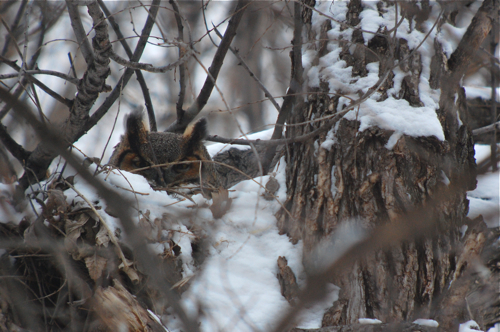
I have a great horned owl nesting within walking distance from my home. I have mixed feelings about blogging it. On the one hand, I get the wisdom of keeping nests on the down lo. On the other hand, I live in a very urban area and these birds have chosen to nest in a particularly high traffic spot. I think they knew what they were getting into. There are all sorts of people well aware of the nest and happy to walk up to any stranger and say, "Hey, there's owl right there!"
I'm not going to reveal the exact location, but that still won't stop some complainers. Last winter, a birding organization received an email asking that something be done about me because I had revealed a northern hawk owl perching location in my blog, it wasn't even nesting. I thought it was funny that an organization that I'm not associated with got such an email (what are they gonna do, fire me). It's no secret you can find northern hawk owls at Sax Zim Bog and I had gotten the location from a website promoting where to find the owls. Ah well, haters gotta hate, as the young kids say these days.
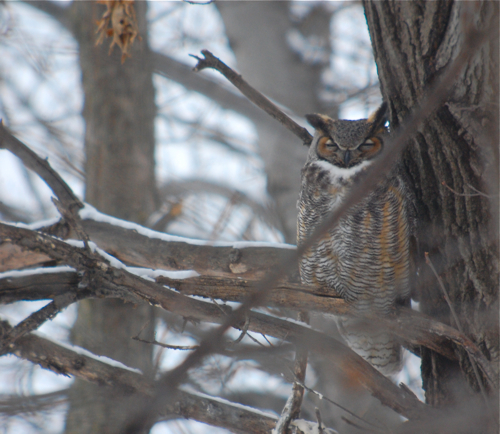
Here's the male keeping watch near the nest, even though it looks like his eyes are closed, those little slits are open and he's keeping an eye on me with my scope.
So, what should you do if you find an owl nest? I think keeping the exact location hidden from the local birding listservs, Twitter, Facebook and FourSquare is a good idea. But when you find something so cool, there can be a huge temptation to share it. Be cautious with how many people you tell. Locations should be shared to some groups--say for instance a place like The Raptor Center. If orphaned great horned owl chicks end up in their clinic, they try to find surrogate nests for the chicks. You could also submit it to Nestwatch a website trying to document bird nesting throughout the US. If someone is keeping track of breeding birds for an overall study or atlas, that would be a good idea too. These could be safe ways of documenting the nesting process, a fun project for you, but won't bring hoards of people to the nest site.
I'm sure I'll be walking by and checking these birds out throughout the spring. I have an idea of when incubation started so hopefully some owl chick photos will come along. I'll be curious to note the number of people, especially those walking their dogs who will walk past it without realizing it's there.
I'll also be curious to see how the nest holds up. Great horned owls do not build a nest, but take over old hawk, crow or squirrel nests. I'm pretty sure that meatball of leaves the female owl is hunkered on is an old squirrel nest. She had lots of squirrel nests to choose from, some more secluded than others. It's interesting she chose one in a well traveled. Here's hoping that this turns out to be a big win for urban great horned owl nesting this spring.
Birding & Wheaton's Law
I usually avoid "stake out" birds (rare birds reported in someone's yard or park and you show up and BOOM it's there). I don't think they bring out the best behavior in anyone--myself included. This is especially true when it comes to owls. Everyone has such a STRONG opinion as to whether or not you should report owls. It leads to a lot of debate on listservs and forums. Some say to never report a roosting owl ever. Others say that you shouldn't keep bird reports to yourself. Some won't report them publicly, but collect them and then will privately communicate them when asked, but this leads to accusations that the person collecting the sightings won't give out the right directions if they don't like the person who asked. There's also the poor new birder who gets lambasted for reporting an owl and had no idea so many people think it's "poor form" to report them. And then you have owls that break convention and roost in heavily trafficked parks. But when I saw that a northern saw-whet owl was reported in a yard in the Twin Cities with the homeowner saying, "Come on over," I couldn't resist the siren song of a 40 degree, sunny day and a quick and easy owl fix.

Even Non Birding Bill couldn't resist coming along. Above is a photo he took of the owl with his iPhone through my Swarovski Spotting Scope. I cocked an eyebrow when he took it as an Instagram (Really, with my fancy scope and its incredible light gathering ability, you make it look like and old and faded photo?Sigh.).

When I arrived, there were six people with large camera lenses on the bird. There were stationed in a quarter circle around the owl. It was easy to spot--follow all the lenses. As I set up my digiscoping equipment, I realized I forgot to put an SD card in my SLR. Fortunately, we had NBB's iPhone and I brought along an HD video camera and took video (that's a still from the video camera above). It was a quiet and hushed affair. All of us positioned at the best sun angle we could find and a comfortable distance from the owl...but that changed and I was reminded of Wheaton's Law and one of the reason's I don't like stake out birds.
[youtube]http://www.youtube.com/watch?v=GFzAsnyj8eE[/youtube]
If you can't see the video, one of the photographers walked in front of us, didn't bother to ask, "hey can I come past," (or walk behind). It was obvious that my camera was not a still motion camera so it wasn't like he assumed I wasn't taking a photo since my camera wasn't clicking. Bu I instantly thought of Wheaton's Law (originally meant for gaming, but can be applied elsewhere) it's, "Don't be a Dick!"
The dickish behavior didn't stop there. The photographer then went down the hill we were on and got within 10 feet of the tree it was roosting in...with his big ass camera lens.

The saw-whet owl is in the red circle. You do not need to be that close to a saw-whet owl with that size of a camera lens. If the bird flies towards you, then go for it. But this sort of action could make the bird leave this roosting and hunting area which is stressful for the bird and ruins the opportunity for other birders to see it.

The owl tried to watch the photographer with closed eyes. This what they do for camouflage. Keep the eyes as closed as possible to help blend in with the bark. I think the bird is used to human activity--this is a busy urban yard on a busy street, it's used to people being around and making noise. What it probably is not used to is suddenly having 6 - 12 people staring at it all day long and lurking closer and closer. In the wild, if you are stared at, you're about to be challenged or pursued as prey, generally, wild animals don't like it.
There's a time and a place for confronting this behavior--and I decided that given the silence of everyone else and how close this person was to the owl, starting argument was not going to help the bird. So, we left. I thought I would come by later that day and bring my neighbor Zoe who is not a birder but loves owls.
When I returned with Zoe, I walked through the gate as I had before, only to find no birders. Some movement caught my attention in my peripheral vision and found that all the birders had moved to the home owner's balcony, as the saw-whet had moved towards the house--if we kept walking, we could have flushed the owl(accidental dickish behavior on my part). Zoe and I hightailed it out of there and luckily did not flush the bird.

The saw-whet owl had flown over a woodpile up against the house--I bet there's some good mousing there! I wondered if the bird flew there of it's own accord or if it flushed to there because of the photographer from earlier? Zoe and I jockeyed for position on the tiny balcony, I tried to maneuver my scope between deck rails and birder legs to digiscope a shot of the owl:

As Zoe and I were giddily chatting about Minnesota's smallest and arguably cutest owl, one of the birders kept shushing us. At one point he angrily hissed at me, "You're making it turn its head, be quiet!"
I started to mumble, "Dude, this is an urban yard and this bird has hearing beyond our comprehension, I think it's knows we're here."
And then I realized--I was violating Wheaton's Law. I was being the total dick for this birder and I needed to cut it out. See, stake about birds don't bring out the best in anyone (apart from the poor saint who is willing to allow hundreds of strangers into his home with muddy shoes to look at the bird).

Eventually, the man who wanted silence left and more birders arrived and chatting resumed. I tried to atone for my dickish behavior by sharing my scope with those who didn't have one. As more birders arrived, Zoe and I abandoned our perch on the small balcony and headed home.

Ah, look at that tiny talon. It's always hard to remember that saw-whets, though wee are in actuality, Nature's Perfect Killing Machine.
Screech Owl Kind Of Day
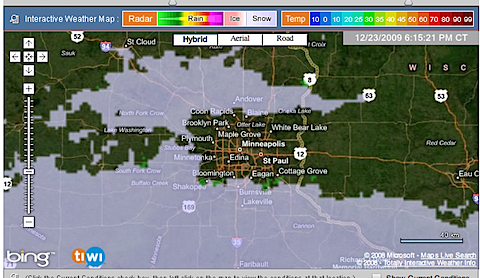 As I type this entry, this is what the snow cloud RADAR looks like from KSTP. Non Birding Bill and I live in Minneapolis. The surrounding clouds kind of look like Oogie Boogie Man from The Nightmare Before Christmas about to nom us up. We may also be feeling the benefits of the bubble effect, sometimes big storms pass around the Twin Cities rather than right through. I am suspicious of the hype with this storm. Suspicious that we will not get the 24 inches predicted all week. NBB says I'm crazy to doubt this, but I'll believe Snomaggedon when I see it.
As I type this entry, this is what the snow cloud RADAR looks like from KSTP. Non Birding Bill and I live in Minneapolis. The surrounding clouds kind of look like Oogie Boogie Man from The Nightmare Before Christmas about to nom us up. We may also be feeling the benefits of the bubble effect, sometimes big storms pass around the Twin Cities rather than right through. I am suspicious of the hype with this storm. Suspicious that we will not get the 24 inches predicted all week. NBB says I'm crazy to doubt this, but I'll believe Snomaggedon when I see it.
I thought I'd go out and do some birding before the pending Snowpacolypse today. I wanted to see if I could find a snowy owl at the Minneapolis St Paul Airport but did not--got totally skunked. All I found were eagles and a few snow buntings. I ran into my buddy Linda and her husband and she told me about an eastern screech-owl that was visible from one of the trails at Minnehaha Park.
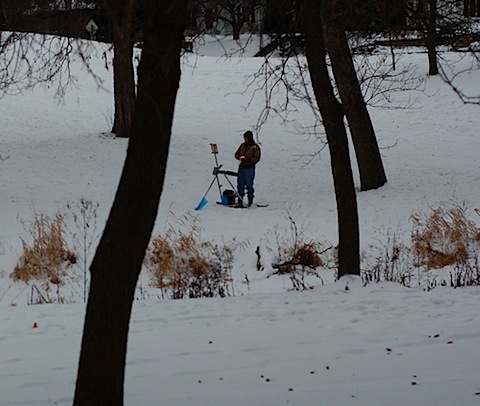
When I arrived at the park, I could see the true spirit of the Minnesota. There was an artist out with his easel set up and all his layers appropriately applied so he could do a landscape in oils of the frozen creek. It was twenty-nine degrees, so with some well placed SmartWool socks, he could be quite comfortable while he painted the landscape with the snow that we have already accumulated this month. I searched the surrounding tree based on Linda's instructions. I scanned for every potential cavity then was surprised when I found the owl roosting in a cavity up above the artist! The artist's back was to the owl, he had no idea of the tiny silent sentry keeping watch while he worked his oils.
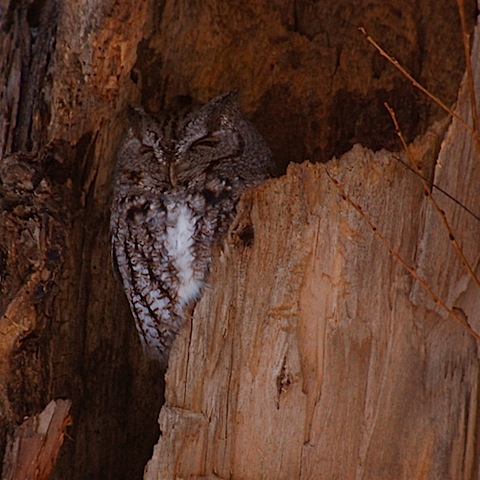
I got a few photos of the gray phase eastern screech-owl (I even took a photo with by hand holding my Blackberry to my scope and sent it to Twitter), then went over to the artist to point out the owl. I think he was expecting something larger, but still found it cool. I know screeches are urban owls, years ago there was a pair of red phases nesting a few blocks from our apartment. This bird seemed very used to this spot, I noted the well worn sledding tracks right beneath and around the tree with the owl's roost--this owl is very used to people.
Trees aren't the only place to look for screech-owls. Yesterday, I got a photo in my inbox. Someone had a surprise roosting in the slot for their daily newspaper below the mailbox:
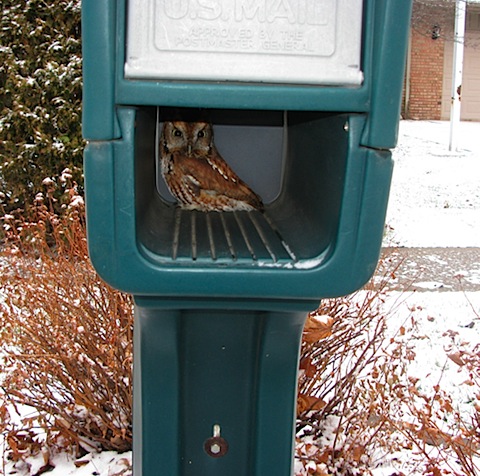
A red phase eastern screech-owl (the same species I saw, but just a different color variation). I did not take this photo. The photographer lives in the Midwest but would prefer that their name not show up on the Internet. Screech owls naturally nest and roost in old woodpecker cavities, kestrel boxes or wood duck boxes. Sometimes, if they can't find a cavity, they make do with an unusual structure. Another reason to put up a wood duck box or let old trees with cavities stay up if they are in a spot that won't risk damage to your home.
Now to watch and see if we get any of the snOMG!
Birding Sax Zim Bog
I really hate car shopping. When we had to go through the process a few weeks ago, I heard through the MN birding grapevine that several northern hawk owls were reported in northern Minnesota, I decided a day up to Sax Zim Bog with my good friend Amber would be my reward. Besides, what better way to get to know our Kia Pet (the named dubbed to our very beige vehicle because it looks like a Chia Pet before the grass grows out) than by taking it on an all day birding trip?
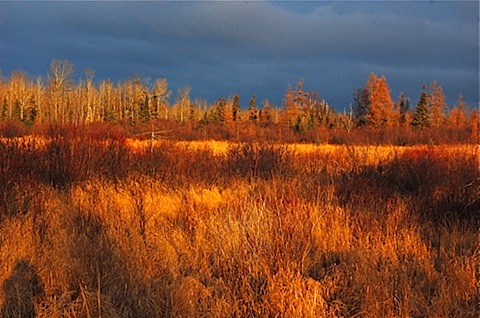
Since daylight is short, Amber and I left the Twin Cities early to arrive at Sax Zim Bog just after sunrise and get some great photography light. Our plan seemed to work. The light was great when we arrived, and dark clouds in the distance only enhanced the bog's colorful landscape.
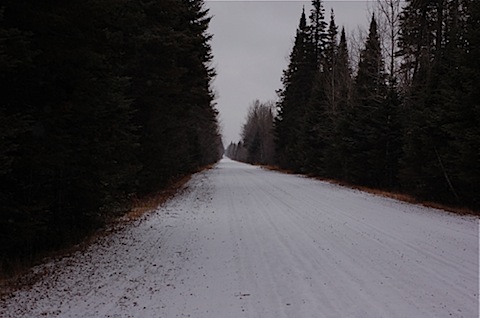
Alas, the sun was a total tease and soon hid behind clouds that brought light snow. On the upside, I got to really test out the Kia Pet's brakes and refamiliarize myself with driving on snow and a few patches of black ice. Whoopee, I stayed out of the ditches. I do laugh, we've had this vehicle for a couple weeks now and I still drive it like our old sensitive Saturn, like pausing before I press the gas to go in reverse. You had to give the Saturn a minute to think about it or she wouldn't reverse or would jerk violently into it. I forget with this car, I reverse without pause. Ah, the joy of driving a reliable car! But back to birding the bog...
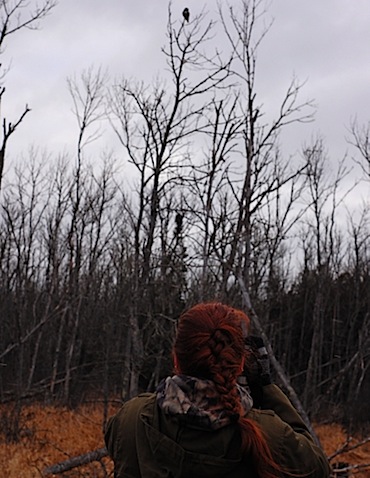
We got a northern hawk owl right away near the corner of 7 & 133 near Meadowlands. If you are interested, there's a google map of where northern hawk owls have been reported which members of the Minnesota Ornithologists' Union add sightings to help those who visit the bog. There appears to be a small irruption of hawk owls this year (perhaps a crash in the vole population on their breeding grounds, pushing quite a few owls south into Minnesota). It's not on the scale of the owl irruption of 2004/2005 but we will never see the likes of that again...or at least not in our lifetime.
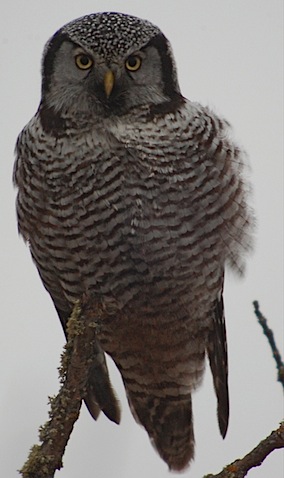
This bird put on quite a show for us, as it was actively hunting. It dove down into the grasses, we could see it scurry though and then fly back up. This spot is right next to some railroad tracks and is a road that's used quite a bit in the bog. I'm always fascinated by an owl's ability to hear any prey in a spot like that. I must say, I'm loving the Nikon D40 for digiscoping. This photo turned out way better than it should have considering how low the light conditions were. In the past I've used point and shoot cameras for digiscoping with my Swarovski scope and I would have gotten blogable photo, but nothing this clear on a cloudy day. We ended up seeing a second northern hawk owl as we meandered around the bog, but it was much further away from the road and flew off to parts unknown. I couldn't believe we got our target bird so early.
But the blog is not just about owls, there are so many great birds to find this time of year!
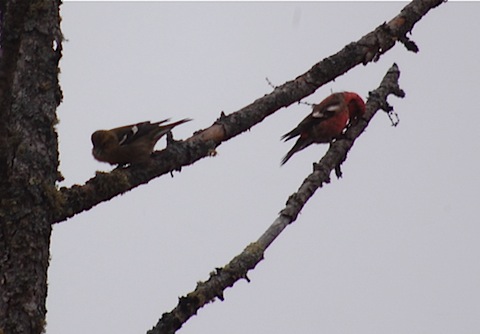
We used the MOU's Sax Zim Bog site maps (particularly the Birding Roads tab) and went looking for birds. Any time we saw a flock of birds land nearby, we pulled over to investigate. We found a small flock of white-winged crossbills working their way through.
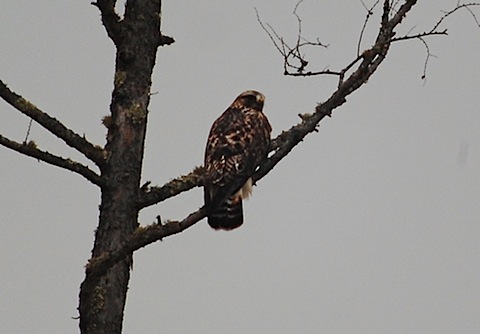
We also saw about a dozen rough-legged hawks--each one different (we even saw a couple of dark morph birds). We saw many bald eagles as well but we did note that we did not see any red-tailed hawks, interesting change of buteos. The rough legs are very cagey and hard to get photos of. No matter how far away you park, as soon as the scope is trained on them, they poop (a sure sign they are about to fly)...
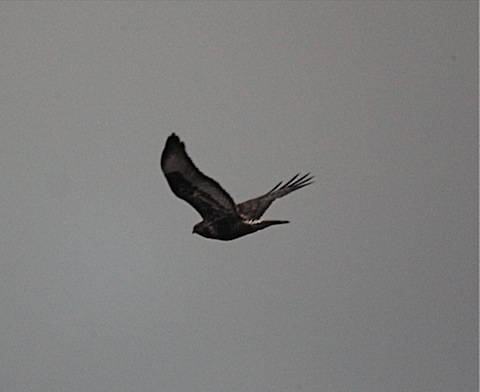
This is a different bird than the one perched above--very dark, almost a dark morph. It's cool to see them in so many different color variations. One of the things I love about living in Minnesota is that a day's drive at the right time of year can give you a completely different set of birds. In the Twin Cities, we're loaded with red-tailed hawks. A two and half hour drive north and we're surrounded by rough-legged hawks. Awesome to have a change of pace.
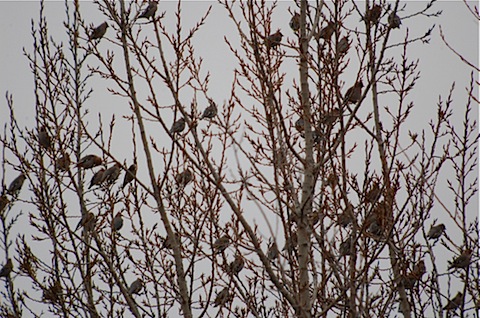
Speaking of a change of pace, Amber and I started following another large flock of birds. When they landed, I rolled down the car windows and was excited to hear the louder and deeper trills of bohemian waxwings.
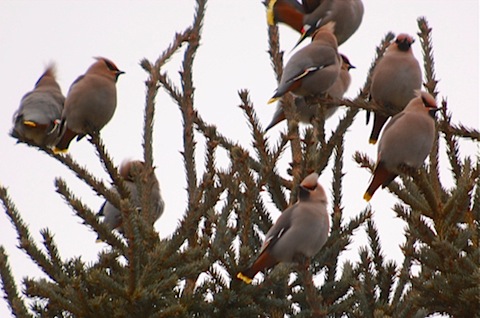
Here's a closer photo of them. Can you spot the differences between these and a cedar waxwing? If you follow this link, you'll see photos of cedars--they have white butts. The above bohemians have rusty butts. Bohemians also have a red and white patch on their wings. So, cool--a different type of waxwing too! I tried to get a video so you could hear the difference in their calls, but the wind blocks it a bit:
At Xeno Canto, you can also here the difference. This is the sound of cedar waxwings and then this is the bohemian waxwings.
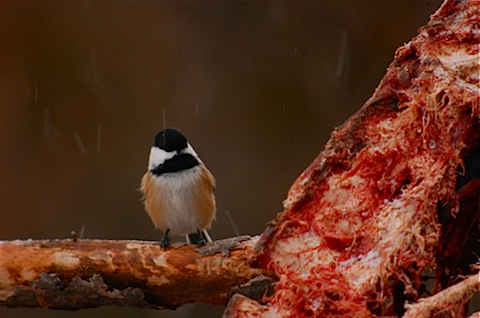
We drove down Admiral Road where a deer carcass is usually hung. In the past this has been a great spot for all sorts of birds. Amber and I found that a deer carcass was already up. Black-capped chickadees and down woodpeckers snuck it for bits of fat and meat.
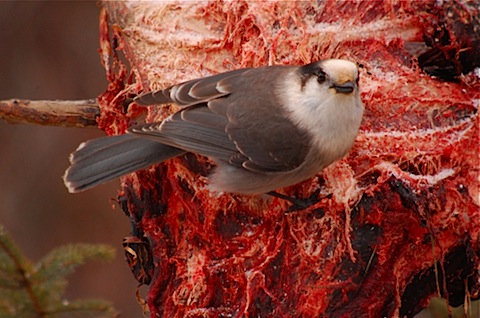
As did about five gray jays (who kind of look like a balding chickadee on steroids). I showed this video to Non Birding Bill and he said it reminded him of Hannibal Lecter which led to this photo caption. There ended up being about five gray jays who came in for the food source. It was interesting to watch the difference in these jays, the crept in quietly like the snow for the food. I'm so used to blue jays--or even green jays or Steller's jays who noisily announce their presence before coming into a feeding station. These birds swooped in secretively, very unjay-like.
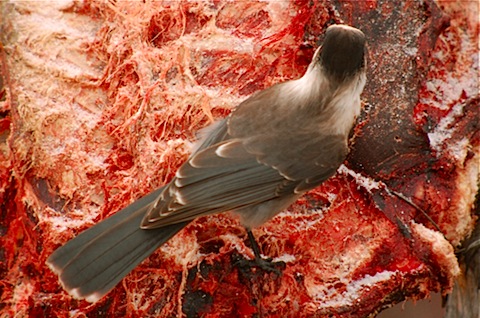
I loved the contrast of the ragged, bloody cage compared to the soft feathery gray of the jay. I took a ton of photos, but the wind picked up at this point and my eyes were watering, I could barely focus my scope.
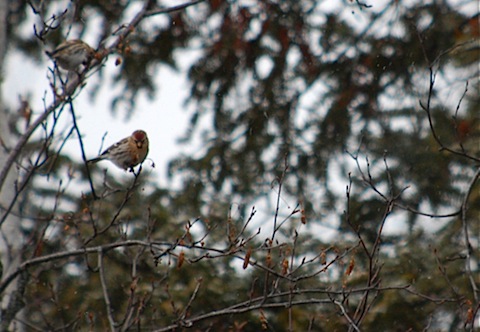
We also came across several flocks of common redpolls feeding on birch seeds. It was great to see them eating on a natural food source and not a feeder (not that I won't take them at a feeder, but I read they eat birch seeds, I enjoy seeing a bird doing what a researcher tells me they do). We've already had pine siskins show up at Mr. Neil's. I wonder if we'll get redpolls too?
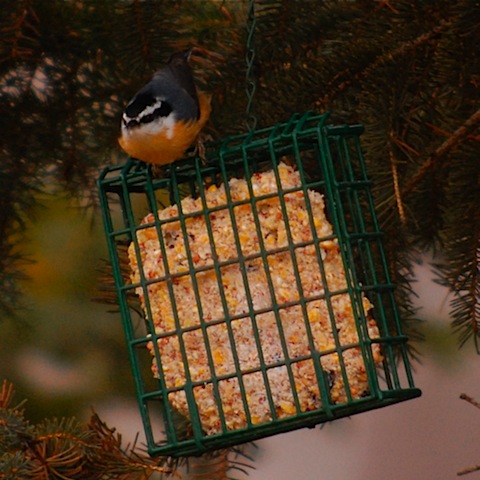 We also stopped at one of the feeding stations open for public viewing at the bog (which was innundated with red-breasted nuthatches). One of the residents has been kind enough to put bird feeders at the end of their driveway and you can park across the street and stand at the end of the driveway and enjoy the birds. In the past, this has been chock full of birds. She came out to greet us and said they had just put the feeders up so the birds were just discovering it. There's normally a little box requesting donations for bird food, she hadn't even had time to put that out yet (so we put a few bucks in her mailbox as a thank you).
All in all it was a GREAT day. We didn't see every bird possible--no boreal chickadee or great gray owl so Amber and I decided that we're going to have to take another day and bird the crap out of the bog.
We also stopped at one of the feeding stations open for public viewing at the bog (which was innundated with red-breasted nuthatches). One of the residents has been kind enough to put bird feeders at the end of their driveway and you can park across the street and stand at the end of the driveway and enjoy the birds. In the past, this has been chock full of birds. She came out to greet us and said they had just put the feeders up so the birds were just discovering it. There's normally a little box requesting donations for bird food, she hadn't even had time to put that out yet (so we put a few bucks in her mailbox as a thank you).
All in all it was a GREAT day. We didn't see every bird possible--no boreal chickadee or great gray owl so Amber and I decided that we're going to have to take another day and bird the crap out of the bog.
Great Horned Owl Nesting In Planter
So, with all my crazy travels, it's been tough to keep up with all my back emails. Boy, have I missed a whopper! Thank you, so, so much to Robbyn Spratt for sending this my way! Brace yourself, are you ready for this? Okay, here it goes:
There's a great horned owl nesting in a planter in Viera, FL.
 Yes, you read that correctly. Viera, FL home of one of my all time favorite birding spots, Viera Wetlands has an owl nesting in a pot! Apparently, a pair of great horned owls chose to use a planter outside of the Brevard County Commission and the eggs have hatched--there is even a LIVE owl cam. The camera does not appear to be visible at night, however, there are clips that you can watch any time, so bookmark the Brevard County Owl Cam for some on the job entertainment.
Yes, you read that correctly. Viera, FL home of one of my all time favorite birding spots, Viera Wetlands has an owl nesting in a pot! Apparently, a pair of great horned owls chose to use a planter outside of the Brevard County Commission and the eggs have hatched--there is even a LIVE owl cam. The camera does not appear to be visible at night, however, there are clips that you can watch any time, so bookmark the Brevard County Owl Cam for some on the job entertainment.
This is an awesome diversion, especially since the owls at the Valmont Owl Cam appear to be having issues.
Raptor Center On MPR about 08/09 Snowy Owl Irruption
You can read or listen to the story here. Do check it out, there are some great shots of the birds!
Snowy Owl At The Minneapolis Airport
Last week at Birds and Beers, we talked about snowy owls that are usually seen at the Minneapolis/St Paul Airport in winter. None had been reported at the airport yet (they've been showing up all over elsewhere in Minnesota and in Wisconsin). I've been checking the airport a few times a week (I live nearby) and we had a couple of people who actually work at the airport show up to Birds and Beers and they had not seen or heard any reports. Then, last night someone reported on the local birding listservs that they saw one on Cargo Rd.
When I finished my volunteer shift at The Raptor Center at about noon, I headed over to try my luck. Normally, I would search of the owls after 3pm, since they are more likely to be seen later in the day but the temps were below zero degrees Fahrenheit and a snow storm hit, so I figured my chances were good.
And they were! I drove right underneath a snowy owl! The challenge at the airport is that there are few places airport security would like you to stop and take photos. I think MSP Airport Security must have my license plate on file by now. So many people have made such a big show of writing down my plate number when they see my digiscoping equipment and I never get pulled over by security. They must think, "Ah, it's one of those birders again." I make sure to follow the rules--do what the signs say, like stay six feet away from fences. Also, the glycol plant manager used to collect owl pellets for me, so if I pull over for a photo, I do it in their driveway and only very briefly. I avoid stopping in the road, because it's not safe. Today someone stopped in the road on a downhill curve and I almost hit them since the roads were slick with the freshly falling snow--not cool and the kind of antics that make airport security less forgiving of birders. I'm not sure if the stopped person was a birder or just some regular person shocked to see a huge owl on a light post in the middle of the day.
Not only did I manage to digiscope a few snowy owl photos quickly, but I heard the owl vocalize (some weird bark and nothing remotely hoot-ish) and then watched it dive for prey. Alas, it came up empty taloned, but was cool nonetheless.
The owl returned to the light post and I managed one more photo before airport security pulled up behind me and gave me the hairy eyeball. I paused to make sure he didn't want to come out and wag his finger, but with the temps so cold, he stayed in his truck and glared. I hightailed it out of there to do some more digiscoping at the Minnesota Valley Wildlife Refuge Headquarters and ended up with a general awesome afternoon. More on that later.
